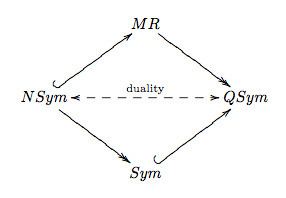 | ||
In algebra and in particular in algebraic combinatorics, a quasisymmetric function is any element in the ring of quasisymmetric functions which is in turn a subring of the formal power series ring with a countable number of variables. This ring generalizes the ring of symmetric functions. This ring can be realized as a specific limit of the rings of quasisymmetric polynomials in n variables, as n goes to infinity. This ring serves as universal structure in which relations between quasisymmetric polynomials can be expressed in a way independent of the number n of variables (but its elements are neither polynomials nor functions).
Contents
Definitions
The ring of quasisymmetric functions, denoted QSym, can be defined over any commutative ring R such as the integers. Quasisymmetric functions are power series of bounded degree in variables
A quasisymmetric function in finitely many variables is a quasisymmetric polynomial. Both symmetric and quasisymmetric polynomials may be characterized in terms of actions of the symmetric group
The simplest symmetric function containing all of these monomials is
Important bases
QSym is a graded R-algebra, decomposing as
where
The fundamental basis consists
where
Then one can define the algebra of symmetric functions
Other important bases for quasisymmetric functions include the basis of quasisymmetric Schur functions, and bases related to enumeration in matroids.
Applications
Quasisymmetric functions have been applied in enumerative combinatorics, symmetric function theory, representation theory, and number theory. Applications of quasisymmetric functions include enumeration of P-partitions, permutations, tableaux, chains of posets, reduced decompositions in finite Coxeter groups (via Stanley symmetric functions), and parking functions. In symmetric function theory and representation theory, applications include the study of Schubert polynomials, Macdonald polynomials, Hecke algebras, and Kazhdan–Lusztig polynomials. Often quasisymmetric functions provide a powerful bridge between combinatorial structures and symmetric functions.
Related algebras
As a graded Hopf algebra, the dual of the ring of quasisymmetric functions is the ring of noncommutative symmetric functions. Every symmetric function is also a quasisymmetric function, and hence the ring of symmetric functions is a subalgebra of the ring of quasisymmetric functions.
The ring of quasisymmetric functions is the terminal object in category of graded Hopf algebras with a single character. Hence any such Hopf algebra has a morphism to the ring of quasisymmetric functions.
One example of this is the peak algebra.
Other related algebras
The Malvenuto–Reutenauer algebra is a Hopf algebra based on permutations that relates the rings of symmetric functions, quasisymmetric functions, and noncommutative symmetric functions, (denoted Sym, QSym, and NSym respectively), as depicted the following commutative diagram. The duality between QSym and NSym mentioned above is reflected in the main diagonal of this diagram.
Many related Hopf algebras were constructed from Hopf monoids in the category of species by Aguiar and Majahan .
One can also construct the ring of quasisymmetric functions in noncommuting variables.
